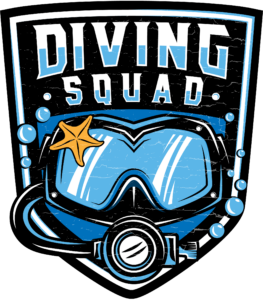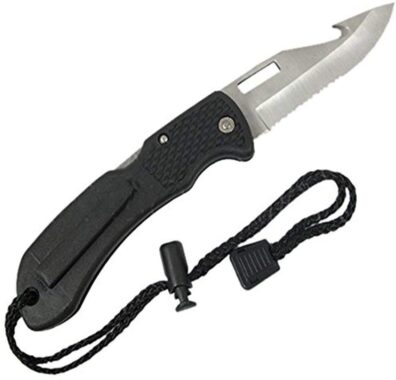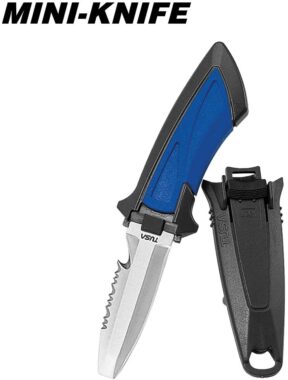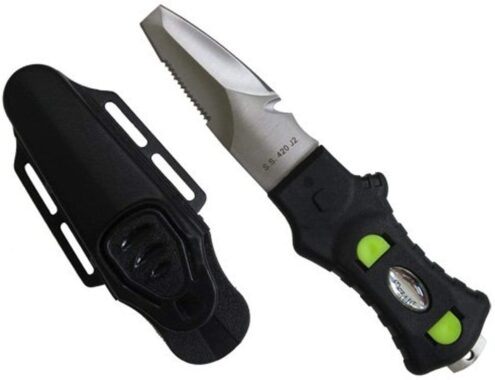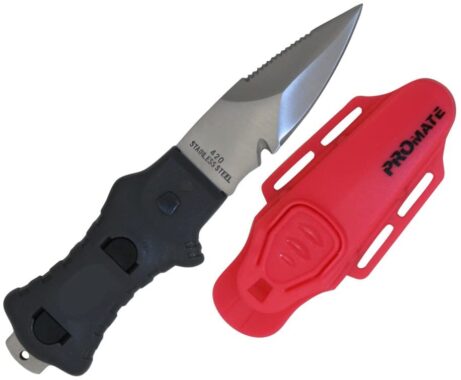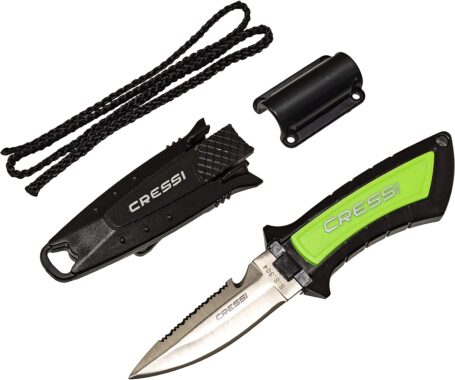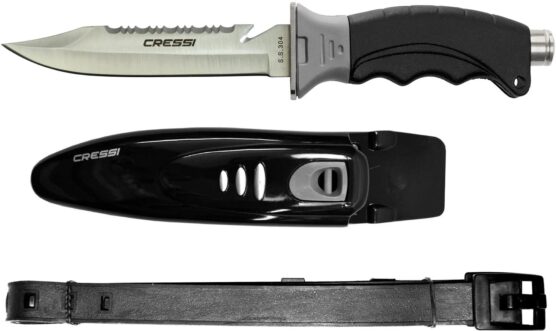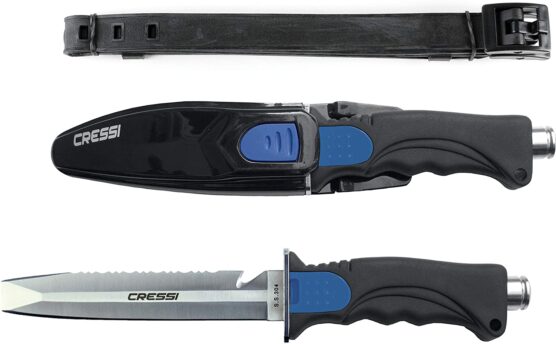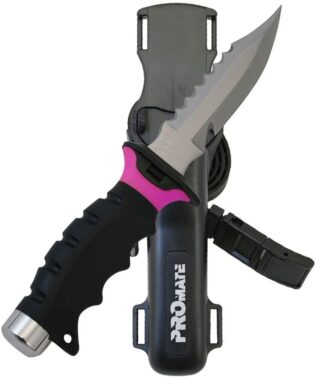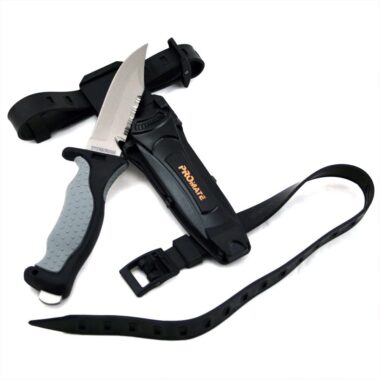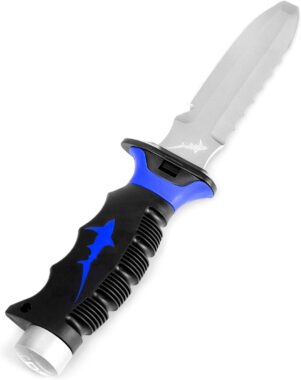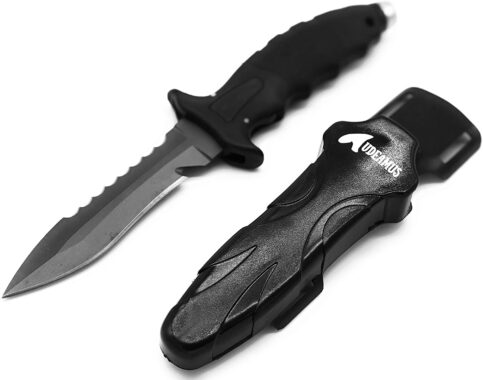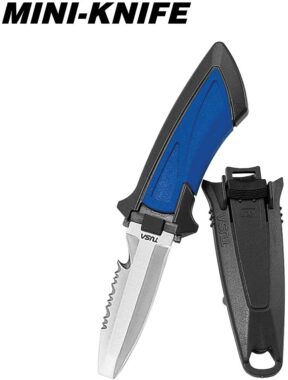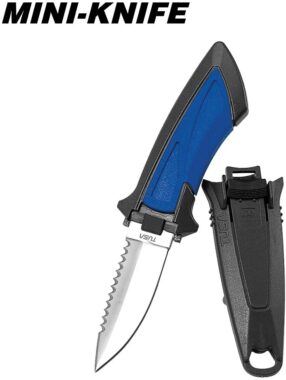
Best Dive Knives | 2024 Scuba Diver Knife Reviews
Dive knives are a useful accessory for scuba divers. They can be a literal lifesaver if you, your dive buddy or a marine animal have become entangled in a fishing line.
A dive knife is different to a regular knife by being rust-resistant, easily attached to a BCD and usually featuring a line cutting notch.
A quick glance online will show countless different dive knives available. They vary by blade length, handle style, materials and means of attachment.
So which dive knife is best for you!? Is it sensible to pick one that is small and compact or better to have a huge, underwater weapon that you could carve up a Great White Shark with?!
Read on for our 12 brutally honest reviews of the best scuba knives available in 2024; based on our own experiences as totally badass, knife wielding scuba divers.
There’s 4 parts to this article:
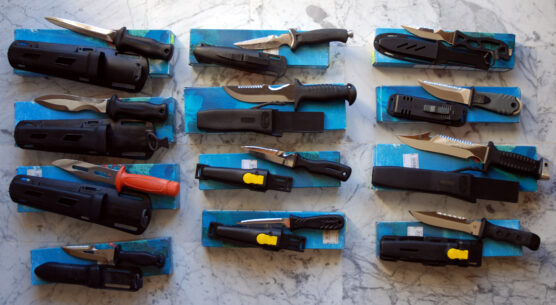
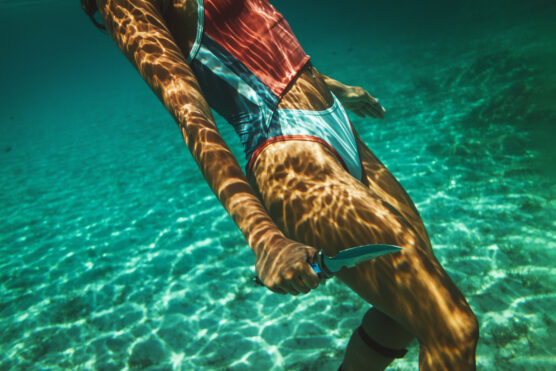
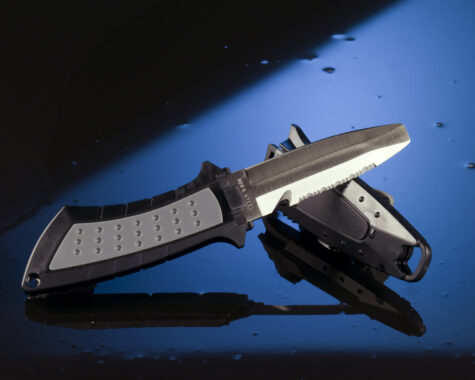
QUICK LOOK
- Best Cheap Dive Knife: Scuba Choice Foldable Knife
- Entry-Level Blunt Dive Knife: Tusa FK-11 Mini Dive Knife
- Cheapest Blunt Tip Diving Knife: Scuba Choice Compact Blunt BCD Knife
- Compact Full Tang Diving Knife: Promate Point Tip (3’’) Dive Knife
- Short Blade Diving Knife: Cressi Lima
- Longest Dive Knife: Cressi Borg Long Blade Diving Knife
- Excellent Value Dive Knife: Cressi Skorpion Stainless Steel Blade
- Cheapest 5” Knife: Promate Sharp Tip Scuba Diving Knife
- TOP PICK: Best Dive Knife Overall: Promate Titanium (4 3/8’’) Scuba Dive Knife
- Cheapest 5” Titanium Diving Knife: Thresher 5’’ Titanium Dive Knife
- Best 5” Diving Knife : Audeamus Titanium Dive Knife
REVIEWS of Best Dive Knives
1) Best Cheap Dive Knife: Scuba Choice Foldable
Diving knives can get quite expensive, so it can be difficult to find a good quality entry-level option. Luckily, Scuba Choice has your back with this sleek and well-rounded stainless steel diving knife.
This is the most affordable option on our list as well as being the only foldable knife. It’s perfect for tucking in the best BCD pockets as a main or backup knife.
The Scuba Choice Foldable Knife has a 3.5’’ stainless steel blade and if treated properly with a wash and oil after each dive will last long without any rust.
On the spine, there is a line cutting notch, while the main side is split into a serrated section and a straight edge before ending in a sharp tip.
The knife’s butt and handle are both plastic but it has an ergonomic design that will feel comfortable in your hand.
To open the knife, you simply need to pull the blade out – there is no locking mechanism when closed. The blade will, however, lock firmly into place when fully extended.
If you’re on a tight budget but looking for a decent quality and compact dive knife that’s easy to use, this is the choice for you!
PROS:
- Excellent value for money
- Compact/foldable design can fit in BCD pocket
- Attractive price point for titanium diving knives
CONS:
- Doesn’t lock in place with closed
- Plastic butt
2) Entry-Level Blunt Dive Knife: usa FK-11 Mini Dive Knife
Tusa is a well-known diving brand and this entry-level blunt knife gets our nod of approval. It features a compact design with a 2 7/8’’ stainless steel blade that can be used in almost any situation.
The sturdy locking mechanism is a great addition at this price range and will leave you confident that your knife isn’t slipping out while you’re out diving.
The synthetic handle is comfortable and the perfect size for most people, but if your hands are a bit bigger than average you might prefer an underwater knife that has a bit more to hold onto.
This knife does not come with a strap, instead offering a hose mount which you should make sure is properly secured before diving.
The blade, although compact, comes with all the attachments you need. One side of the blade has a full-length sharp edge and the other side has a serrated edge with a sharp notch for easily cutting fishing line.
Stylish, efficient and compact, this is the Diving Squad back-up dive knife of choice!
PROS:
- Well-priced beginner knife
- Blade has all the necessary features
- Secure knife clip
CONS:
- Bit small for people with bigger hands
3) Cheapest Blunt Tip Diving Knife: Scuba Choice Compact Blunt
Scuba Choice does it again. This affordable diving knife is the second cheapest knife we’re reviewing and also the cheapest one with a blunt tip.
For those that are concerned about the safety involved with a sharp tip, but still looking for something well-priced, look no further than this stainless steel BCD knife.
The 2.3’’ blade has two edges, one serrated side for sawing and one sharp side for cutting. The blunt tip is very useful when it comes to diving because it can be used to pry, dig, hack, or chisel away at obstacles.
Throw in the sharp line-cutting notch and stainless steel butt and you’ve got yourself an affordable all-round diving tool suitable for beginners or experts.
Scuba Choice has used 420-grade stainless steel for this 2.3’’ blade, which will stay sharp for longer than other steels but is more prone to rust and corrosion. It’s important that you maintain this knife properly with a thorough freshwater cleaning and oiling after use.
We love the excellent value for money offered by this efficient and decent quality scuba knife!
PROS:
- Best valued blunt tip diving knife
- Multi-function diving tool – has everything you need
- Attractive price point for titanium knife
CONS:
- Prone to rust if not treated properly
- Short blade may make some cutting jobs difficult
4) Compact Full Tang Diving Knife: Promate Point Tip (3'') Dive Knife
This compact diving knife is sturdy, has an easy-to-use locking mechanism, and has all the necessary features like a line-cutting notch, a serrated edge, and a tank tapper.
The knife notch is on the main edge of the blade, which some find to be a more natural movement. If you need to cut something like wood or cordage, the serrated spine will work well.
There are a few color options available, but this only changes the color of the sheath and not the actual handle. The black handle is molded plastic but is comfortable when holding with or without a diving glove.
The blade is 420-grade steel which is a stronger metal that is less prone to bending or losing its edge. However, this type of steel is less resistant to rust so thorough cleaning, drying, and oiling is recommended after every use.
PROS:
- Sturdy full tang knife that holds up well to use
- Blunt and sharp tip options
- Steel pummel & line notch
CONS:
- 420 steel more prone to rust
- Newer models may have different grade of steel
5) Short Blade Diving Knife: Cressi Lima
The Cressi Lima is the 2nd shortest blade we have reviewed, with just a 2.44’’ blade. The slim handle is suitable for most people and excellent if you struggle with larger knives. However, if you have bigger hands you might find it a little bit difficult to manage.
One of the main selling points of this knife is the sheath. It is reversible, so you can use the knife with your left or right hand, and the locking mechanism can be used with one hand.
The sheath comes with two methods of mounting, either using the plastic belt clip or the BCD hose holder which can be screwed in – guaranteeing a secure knife position that is easily accessible.
Whether you’re using this as your go-to diving knife or you just want to have an emergency knife for backup, the Cressi Lima’s 304-grade blade with a straight edge, serrated spine, and line notch will hold up against abuse from both fresh and saltwater conditions.
PROS:
- Extra screw mountable BCD hose holder
- Reversible sheath
- Comes with a 20’’ lanyard
CONS:
- Locking mechanism may take getting used to
- Can’t be strap mounted
6) Longest Dive Knife: Cressi Borg Long Blade
If you descend into the waters with this bad boy on your leg, you’re bound to get mistaken for Rambo. This is the longest diving knife on our list, with the blade measuring just over 5 ½’’. It has a pointed tip and a miniature bowie-style design.
The handle is made from moulded hard rubber and has finger grips and an extended guard to prevent any accidents while using the knife.
The full length of the blade is a straight edge and on the spine, you’ll find both the serrated section and a deep-grooved line-cutting notch.
The blade and pummel (useful for tank tapping) are made using Japanese 304-grade stainless steel. Although you might need to stay on top of sharpening your knife, you have the comfort of knowing it’s a little bit more resistant to corrosion – just remember to oil it properly.
Perhaps best of all, with the Cressi Borg, you’re gaurenteed to have the biggest dive knife of anyone…allowing you to say “that’s not a dive knife…THIS is a dive knife”! Have fun.
PROS:
- Big enough to fight sea monsters
- Long mounting straps
- Rust-resistant 304 grade steel
CONS:
- Guard not made with same stainless steel – prone to rust
- Plastic locking mechanism can get blocked with sand
7) Excellent Value: Cressi Skorpion Stainless Steel Blade
Despite not being the cheapest knife on the list, the Cressi Skorpion is great value for money due to its longer 4 3/8’’ blade. It is stainless steel, which helps lower costs, but is still 304 grade steel which helps it withstand the onslaught of saltwater better than some budget knives.
You have two choices when purchasing this knife, either a blunt tip or a sharp tip. Both knives are outfitted with full-length serrated blades on the spine as well as a handy line-cutting notch.
The blunt tip is more useful for prying, digging, or chiseling, while the sharp tips are for those that prefer a more traditional knife style with better piercing capabilities.
The handle is comfy and the knife comes with a very basic strap that will do the job, but it might be something worth upgrading if it’s not sitting as comfortably as you like.
PROS:
- Great value for money
- Blunt and sharp tip options
- Steel pummel & line notch
CONS:
- Needs strict knife maintenance to prevent rust
8) Cheapest 5 Inch Knife: Promate Sharp Tip
Longer dive knives can be quite expensive, but Promate has released an option that won’t break the bank. The 5’’ blade is stainless steel and comes with a sharp tip that is useful for puncturing and cutting.
The spine of the blade has a full-length serrated edge which is excellent for sawing and on the cutting side you have a sharp blade with a line cutting notch towards the guard.
Although some cheaper knives can use inferior quality metals that cause rust quicker, Promate has used 304 stainless steel which is more resistant to corrosion – but that doesn’t mean you shouldn’t clean your knife after use.
You can easily mount this longer knife to your lower leg or arm using the quick-release adjustable straps.
If you’re someone who likes matching the color of your diving equipment, there are eight different versions of this knife to choose from.
PROS:
- Excellent price for 5’’ blade length
- Comes with a line-cutting notch and steel pommel
- Can be dismantled for cleaning
CONS:
- Plastic handle can be uncomfortable for some
- Straps can come with clip wrong way round
9) TOP PICK: Promate Titanium (4 3/8'') Scuba Dive Knife
The Promate Titanium Scuba Dive Knife is our number one diving knife choice available this year. It comes equipped with a full tang 4 3/8’’ titanium blade with both sharp tip and blunt tip options – as well as a few stylish handle colors.
The titanium metal blade does mean that you will be paying more for this diving knife compared to Promate’s steel options but it is still very reasonably priced. One side of the blade is serrated with a line cutter and the other side has a full-length straight edge.
Not only is this scuba diver’s knife lightweight and extremely resistant to rust and corrosion, but it is an extremely strong blade that you’ll rarely need to worry about resharpening.
This is one of those ‘rinse off and forget about’ types of knives – perfect for those who don’t have time to think about knife maintenance.
The handle is rubber molded, providing both a comfortable and easy-to-hold grip for a bare hand or when you are wearing diving gloves.
A great addition to this blade is the titanium butt that extends past the handle. This gives you the benefit of using the knife as a tank banger or for hammering.
Stylish, high quality and easy to use, this is our favourite dive knife of all time!
PROS:
- Strong full tang titanium blade with butt
- Rust/corrosion-proof
- Attractive price point for titanium knife
CONS:
- Rubber straps not suitable for thigh
10) Cheapest 5" Titanium Diving Knife: Thresher 5'' Titanium
This is the only 5’’ diving knife on the list that has both sharp tip and blunt tip options available.
While sharp tips do provide additional cutting power, it’s nice to have a longer blade that comes with a blunt nose. This will provide more than enough surface area to cut through any obstacles with either the serrated or straight edge. You’ve also got a line cutter to make things easier.
The handle is spacious and can be held comfortably whether you’re wearing your diving glove or not.
It has a rubberized handle, but they have added a titanium butt so that you can still use the knife as a tank tapper or a hammer.
If you’re worried about where to keep it while diving, the two straps that it comes with are long enough to wrap around any part of your leg or arm. They also feel secure enough to give you confidence that your titanium knife isn’t going to just fall off.
Did we mention that it’s also the only dive knife that has a picture of shark on it?
PROS:
- Reasonably priced for 5’’ titanium blade
- Corrosion-proof
- Holds edge well
CONS:
- Knife locking mechanism can break if hit underwater
11) Best 5" Diving Knife: Audeamus Titanium
The Audeamus Titanium Dive Knife is a black EDP-coated 5’’ knife that is long enough to help you out of any entanglement. It is made from high-grade titanium alloy so you won’t have to worry about maintenance, whether that’s rust prevention or needing to sharpen your blade before every dive.
The knife has a spartan-style design with a sharp tip that is good for puncturing and cutting. There is both a sharp edge and a serrated edge as well as a line cutter, making it perfect for cutting through plastics and cordage or harder objects.
Finding a secure sheath that you can trust is a must. This diver’s knife will notify you with a loud click when you have locked your knife in place – music to a diver’s ears. The straps are also stronger than your average diving knife and can be attached to your leg or arm.
Note: Strapping a knife to your arm isn’t ideal because you can only retrieve it with one hand in an emergency. It’s better to leave your arm clear for a top-quality dive watch instead.
PROS:
- Rust-proof titanium alloy
- High-quality sheath and straps
- Arrives sharp
- Fair pricing
CONS:
- Longer blade not suitable for attaching to BCD
Dive Knives: Parts, Features & Types
There are a few different types of dive knives out there.
It’s important that you know more about these specific features before making a decision.
Not only will you find a knife that you prefer, but choosing the right knife for your dives will improve your safety!
DIVE KNIFE TYPES:
- Sharp Tip (Spartan) vs Blunt Designs
- Stainless Steel vs Titanium
- Line Cutting Notches
- Handle Designs
- Black Blades
- Folded Dive Knives
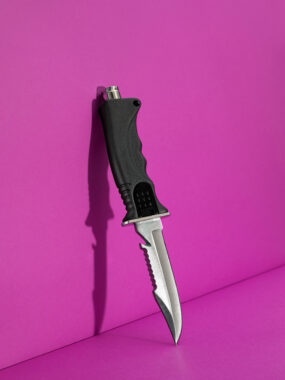
Sharp Tip (Spartan) vs Blunt Designs
One of the first things to consider is whether you want a sharp tip or blunt design dive knife. This refers to the actual design of the blade and the tip. Spartan dive knives have a spear blade shape with a sharp tip, while blunt designs are narrower and have a flat chisel-like (blunt) tip.
Blunt designs are safer for scuba diving because you have a much lower risk of hurting yourself, fellow divers, or aquatic animals without the sharp blade tip. These are also great for prying and using as makeshift screwdrivers.
Stainless Steel vs Titanium
Which material you choose will impact your knife’s strength, durability, weight, and also the price. Stainless steel is the most common material used and also the more affordable option. The only shortcoming of stainless steel is that it is more likely to rust than titanium. However, with proper knife care after each dive, your stainless steel blade can last for a long time.
Titanium is the top shelf when it comes to the best diving knife materials. It is lighter, corrosion-proof, and stays sharp far longer than steel. These lightweight knives are great, but they are also more expensive. If you’re a beginner (or a bit clumsy), the risk of losing your diving knife is quite high so you might be better off using a stainless steel option.
Line Cutting Notches
A small notch in the blade that thin ropes and fishing lines easily fit in, holding them in place and so making them easier to cut.
This simple feature can make the world of difference. Although it might look cooler cutting fishing line with your straight edge, a line-cutting notch just simplifies the process and it’s much safer – let’s keep the dramatic blade cuts for the movies.
The benefit of a line-cutting notch is that you are pulling the knife towards yourself, which helps you get much more power while remaining in control of the blade.
Handle Designs
Choosing the right handle design for you is an important step in finding the perfect diving knife. There are many different handle shapes and materials used, so trying out a few different designs is always your best bet.
Most of the diving knife handles are either synthetic or metal. The synthetic handles are lighter and are often molded with more ergonomic designs. Metal handles are heavier but allow for a much sturdier feel in your hand.
Even synthetic designs can offer a ‘tank tapper’ on the butt, which is simply a piece of metal that can be tapped against your tank to signal others.
Black Blades
You may have noticed that some dive knives come completely black. These EDP (electric-deposit primer) coated knives are more resistant to rusting and corrosion and let’s face it – they look so much cooler.
Although marine animals won’t see a black EDP knife as easily, it will also make it much harder to find the knife if you drop it. There’s nothing worse than dropping your diving knife and having to waste precious time (and oxygen) trying to find it in a poorly lit area.
Folding Dive Knives
You can either choose a dive knife that fits in a sheath or one that folds in on itself. The folded dive knives might take a second longer to get ready when underwater, but they are far more compact and can be safely stored in a BCD pocket.
Choosing where to store your sheath-style diving knife is important for both your safety and your ability to retrieve the knife in sometimes difficult situations. We’ll help you choose the best spot in the next section.
How to Attach a Dive Knife
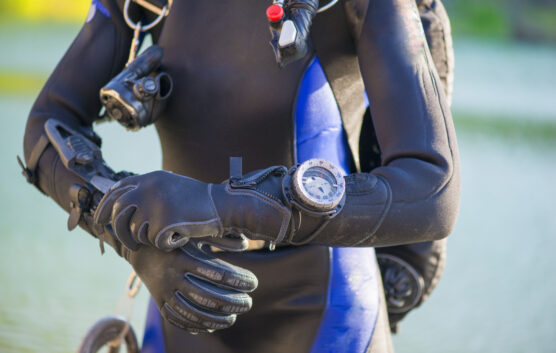
Although descending into the waters with your dive knife drawn might make you feel like a real-life Aquaman / Crocodile Dundee / Underwater Terminator / Special Forces Combat Diver…it’s actually not very practical. When diving, there are a lot of things you need to keep track of, so making sure your knife is in a safe and easy-to-reach location is important.
Note: If you’re using a folding dive knife, then you can easily just store it in your BCD pocket.
How to Attach a Dive Knife:
LEG:
Many first-time scuba divers try to find the biggest knife that they can and then attach it to their leg – don’t worry, we’ve all been there. Although it is a viable option, it can be difficult to retrieve your knife from your lower leg in an emergency. After all, diving knives are for your safety, not just for the looks.
Not only that, but the risk of entanglement is higher than in some of the other spots. If you do opt for attaching your knife here, make sure to do it on the inside of your leg as this will reduce the risk a bit.
BCD:
Your BCD is probably the best place to try and store your knife – if it can fit. Common places include attaching it to the BCD pocket flap, the BCD deflator hose, or even your BCD waistband. Not all BCDs allow you to easily attach a knife to them. The BCD waistband, for example, is only an option if you are using a wing-and-backplate BCD.
Depending on the size of your knife, the shape of its sheath, and your BCD’s design, some of these positions might not be feasible. Attaching your diving knife to your BCD as a beginner lowers the risk of entanglement and also helps you reach it easily during an emergency.
Diving Squad Debriefing:
Whether you’re diving at your local beach or while on holiday in the Great Barrier Reef, a good-quality knife is something we recommend as a must-have piece of equipment. Not only can it help you in a difficult situation, but it might also help your diving partner or even a struggling aquatic animal.
As we’ve seen, there are quite a few different types of dive knives out there, with a wide range of prices, but we have gone through the best of them so that you have everything you need to decide. Now all you need to do is choose your favourite one and you’re ready to hit the water. Crikey!

Support the Squad!
We are part of the Amazon Services LLC Associate Program. If you make a purchase on amazon after clicking a link on Diving Squad, we earn a small commission fee, at no extra cost to yourself.
We are also part of several other affiliate programs so if you click on a Diving Squad affiliate link that results in you booking a liveaboard, booking accommodation, purchasing insurance or buying a product somewhere else, once more we make a small commission, without it costing you a cent extra. Thanks!
Written by:
Jo Richards
